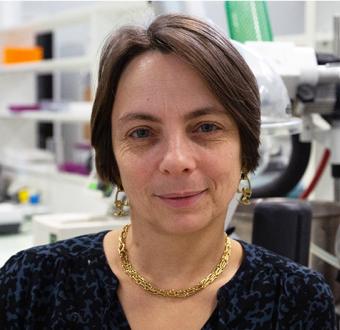
Clotilde POLICAR
Teacher-researcher
Research Director
Dean of the Sciences Education at ENS, deputy director of the Laboratoire des BioMolécules (UMR7203, CNRS, ENS-PSL, SU)
Biology
Chemistry
Bio-inorganic chemistry
ENS-PSL
Published on
22 September 2021
, updated on
14 November 2021
Image

Laboratoire des biomolécules (LBM)
RC
45, rue d'Ulm 75230 Paris cedex 05
01 44 323113
Chemist, trained in organic synthesis, physical chemistry, inorganic spectroscopies, and inorganic chemistry, I am interested in the roles of metals in biology and more particularly in metalloproteins protecting against oxidative stress and I design small complexes reproducing their activity. As subcellular distribution is an essential determinant of bioactivity, imaging of metal cations in biological context is also a field we are actively exploring.
Field of research
In the group « metal in biology (https://www.chimie.ens.fr/bic/) », we are interested in the roles of metal cations in biology in connexion with redox balance. On the one hand, we are working on the design of metalloprotein mimics with antioxidant activity, which we are studying in a cellular context. On the other hand, we preparing metallic systems, which can be used as probes for unconventional imaging (classical fluorescence, infrared imaging or X-ray fluorescence) or in specific contexts (protein aggregation phenomena, as in Alzheimer's disease), or which can be therapeutic (inhibitors of metabolic pathways).
- Antioxidant complexes mimics of antioxidant metalloproteins : we design metal-complexes showing an antioxidant activity to rescue cells from oxidative stress. We study them in cellular models developed in collaboration with gastroenterologists and cell biologists in link with inflammatory bowel diseases (IBD). Some are directly bio-inspired from the antioxidant superoxide dismutase or catalase. In a second strategy, we develop a combinatorial approach to design peptide-based complexes screened for their antioxidant activity. In a third approach, in collaboration with Vince Pecoraro (Michigan univ.), we use three-helices bundles to design de novo peptide and study their anti-superoxide activity.
-Metal-based probes : Re(CO)3 complexes are being developed as multimodal probes to correlate fluorescence, IR-imaging and X-fluorescence imaging. These probes are easily conjugated to any kind of bio-molecule.
Innovative techniques are used to investigate their speciation, quantify them and determine their cellular-location, leading to key information about their behavior inside cells.
Publications
1. Subcellular Imaging in the Mid-IR of a Metal-Carbonyl Moiety using Photothermal Induced Resonance, Clotilde Policar*, Jenny-Birgitta Waern, Marie-Aude Plamont, Sylvain Clède, Céline Mayet, Rui Prazeres, Jean-Michel Ortega, Anne Vessières, Alexandre Dazzi,Angew. Chem., Int. Ed., 2011, 50, 860-864 ;doi : 10.1002/anie.201003161, Highlighted with an inside cover.
2. A Rhenium tris-Carbonyl Derivative as a Single Core Multimodal Probe for Imaging (SCoMPI) Combining Infrared and Luminescent Properties, Sylvain Clède, François Lambert, Christophe Sandt, Zoher Gueroui, Matthieu Réfrégiers, Marie-Aude Plamont, Paul Dumas, Anne Vessières, Clotilde Policar*,Chem. Commun., 2012, 48, 7729–7731; doi : 10.1039/C2CC32163G, IF 6.38 (2012)
3. Entasis Through Hook-and-Loop Fastening in a Glycoligand with Cumulative Weak Forces Stabilizing CuI, Ludivine Garcia, Federico Cisnetti, Natacha Gillet, Régis Guillot, Magali Aumont-Niciase, Jean-Philip Piquemal, Michel Desmadril, François Lambert, Clotilde Policar*, J. Am. Chem. Soc., 2015, 137, 1141−1146 ; DOI: 10.1021/ja510259p
4. Graftable SCoMPIs enable the labeling and X-Ray fluorescence imaging of proteins, Sarah Hostachy, Marie Masuda,Takayuki Miki,Itaru Hamachi,Sandrine Sagan,Olivier Lequin,Kadda Medjoubi,Andrea Somogyi, Nicolas Delsuc*and Clotilde Policar*, Chem. Sci. 2018,9, 4483-4487 ; doi : doi.org/10.1002/chem.201706049
5. The Use of Mn(II) Bound to His-tags as Genetically Encodable Spin-Label for Nanometric Distance Determination in ProteinsH.Y. Vincent Ching, Florencia C. Mascali,Hélène C. Bertrand,Eduardo M. Bruch,Paul Demay-Drouhard,Rodolfo M. Rasia,Clotilde Policar,Leandro C. Tabares,* and Sun Un J. Phys. Chem. Lett., 2016, 7,1072-1076 ; DOI:10.1021/acs.jpclett.6b00362
6. A cell penetrant manganese SOD-mimic is able to complement MnSOD and exerts an anti-inflammatory effect on cellular and animal models of inflammatory bowel diseases, Emilie Mathieu, Anne-Sophie Bernard,Nicolas Delsuc, Elodie Quévrain,Géraldine Gazzah, Barry Lai, Florian Chain,Philippe Langella, Maria Bachelet, Joelle Masliah, Philippe Seksik, and Clotilde Policar*,Inorg Chem. 2017, 56, 2545-2555, doi: http://dx.doi.org/10.1021/acs.inorgchem.6b02695
7. A metallo pro-drug to target Cu(II) in the context of Alzheimer’s diseaseAmandine Conte-Daban,Vinita Ambike,Régis Guillot, Nicolas Delsuc, Clotilde Policar*and Christelle Hureau*, Chem. Eur. J., 2018, 24, 5095 –5099 ;doi: 10.1002/chem.201706049
8. An easy-to-implement combinatorial approach involving an activity-based assay for the discovery of a peptidyl copper complex mimicking superoxide dismutase, Amandine Vincent, Jennifer Rodon-Fores, Elodie Tauziet, Elodie Quévrain, Ágnès Dancs, Amandine Conte-Daban, Anne-Sophie Bernard, Philippe Pelupessy, Koudedja Coulibaly, Philippe Seksik, Christelle Hureau, Katalyn Selmeczi, Clotilde Policar and Nicolas Delsuc*, Chem. Commun., 2020, 56, 399-402, doi: 10.1039/C9CC07920C9
9. A Di copper peptidyl Complex Mimics the Activity of Catalase, a Key Antioxidant Metalloenzyme, Koudedja Coulibaly, Marion Thauvin, Adyn Melenbacher, Clara Testard, Evangelia Trigoni, Amandine Vincent, Martin Stillman, Sophie Vriz, Clotilde Policar, Nicolas Delsuc,Inorg. Chem., 60, 2021, 9309-9319 ; doi : 10.1021/acs.inorgchem.0c03718
10. Rhenium carbonyl complexes bearing methylated triphenylphosphonium cations as antibody-free mitochondria trackers for X-ray fluorescence imaging, Gabrielle Schanne, Lucas Henry, How Chee Ong, Andrea Somogyi, Kadda Medjoubi, Nicolas Delsuc, Clotilde Policar, Felipe García* and Helene C. Bertrand, Inorg. Chem. Front., 2021, 8, 3905-3915 ; doi: 10.1039/d1qi00542a

